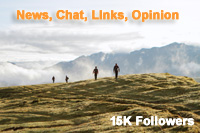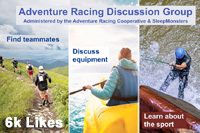Expedition Alaska
How to Outrun a Bear
Pyro / 27.06.2015


Preparations continue. This morning was taken up with more crevasse rescue practice, teams slipping and sliding, setting up C- and Z- hauls and hammering pickets into the grassy slope outside of one of the accommodation lodges. There were a few bemused looks from other visitors to the lodge, a few questions as to what was going on, and the usual quota of glazed and pained expressions at the answer. Pretty much normal for telling anyone about expedition AR.
The topics of conversation around the kegs of beer and cider provided for last night's entertainment were mainly around how the almost continuous daylight will affect sleep strategy. While the area gets to a dusk-like level for three to four hours overnight, there is no period of complete darkness, nothing to take a cue from as to time of day. It will be interesting to see how the teams cope with something that could be a big help to navigation but a hindrance to sleep.
Early afternoon started with a lecture, by one of the lodge staff who works alongside the local Ranger service, entitled 'Bears – the basics'. While not intended to scare the competitors, there were a few nervous laughs in amongst the questions. Since there will probably be time spent sleeping on the course, there was emphasis on how to store food to keep it out of reach, to pack out litter and double-bag everything to reduce the smell, and to keep talking to avoid surprising a bear. Apparently bears in Alaska, both Brown and Black, are apparently used to being hunted and so are wary of humans, but the tips on attack avoidance could be handy. Teams are predominantly hoping not to have to use them, but since it's feeding season and the ranger's assertion that the teams almost certainly WILL see bears during the race. And moose. And possibly wolves. Lots of things that could do you harm. Although at least one team commented that the lecture still wasn't as scary as the snake talk in Ecuador.
The evening's map give-out and initial race briefing followed later on, and was a surprisingly uproarious affair. Dave Adlard spun yarns and weaved anecdotes about the previous Expedition Idaho races into his introductions of the race crew, media and volunteers – with a certain bearded Sleepmonsters reporter being pointed out as “the fuzzy-looking guy in the corner”. It's an oft used cliché, but the team genuinely are acting as a single big family at the moment, with few crew members being outside of a personal friends circle, though with extra volunteer staff coming over from Australia and Portugal, that circle has been extended somewhat recently.
The arrival of the maps, race goodies and route books started the cycle of poring over the details and minutae of the race. The early stages, the lakeside 'prologue' trail run named in honour of Chad Denning and the glacier trek named for Cody Roman Dial, are estimated to take up the whole first day of the race at least for the fastest teams, and a touch more for the rest of the pack, with 30hrs being the standard estimate for teams to get into the first transition area. The teams have some time to look over the maps and get any questions in order before a second briefing tomorrow afternoon, and many had them spread out over the tables in the lodge restaurant at dinner. They have only been given detail of stages one to six initially though, and the distances and activities beyond that will be dictated by the time they take to complete those six. After that, they'll be directed onto a number of loops which will fill the time until the 'Dark Zone' (a curious misnomer for Alaska at this time of year), after which they'll run the infamous Seward 'Mount Marathon' 5km race course as a final fling activity.
For now, they can read up, check logistics and sort their final food allocations out, before a wilderness first aid crash course, the welcome banquet, kit box hand-in and the final briefing tomorrow afternoon. The circus is nearly ready to roll once more…







 SleepMonsters
SleepMonsters



